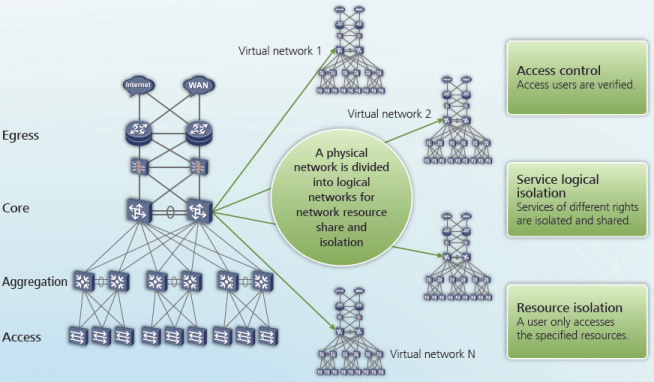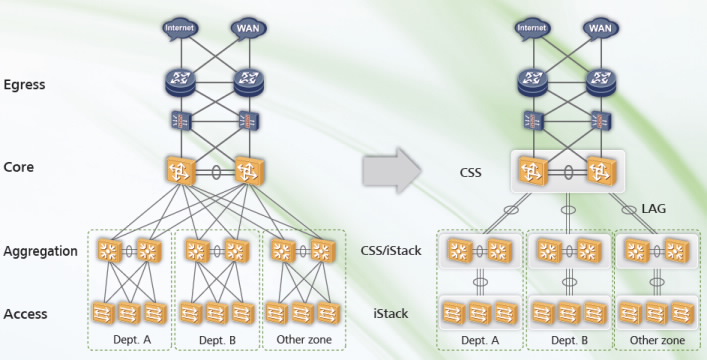According to Kyoto Protocol and Copenhagen Accord, countries all around the world must aim to curb their high energy consumption and CO2 emissions. Countries have carefully considered their environmental protection plans and created governmental policies. Additionally, many industries now have their own environment protection rules and protocols. Energy saving and emission reduction is the obligation of all modern enterprises.
According to industrial statistics, the power consumption of IP and IT devices is 12% of the total power consumption of an enterprise. Therefore, reducing energy consumption of these devices helps an enterprise reduce the Total Cost of Ownership (TCO).
According to the statistics provided by Global e-Sustainability Initiative (GeSI), in 2020, the CO2 emissions reduced by Information and communications technology (ICT) will be five times of the CO2 emissions produced by ICT itself. Green communication is a common objective for people worldwide to unite behind.
Reducing energy consumption of a single device cannot reduce the total energy consumption of a campus network; therefore, Huawei provides an end-to-end energy saving solution:
- The network structure is simple and allows for efficient data forwarding. Redundant devices and links bring unnecessary power consumption.
- All devices support smart energy saving, without affecting services.
- Power consumption of IT devices is managed intelligently.
As an industry-leading solution provider, Huawei has created the One Net green campus network solution to reduce energy consumption for enterprises.
Efficient and Simple Network Structure
Traditional campus networks use Layer 2 technologies such as VLAN to isolate services and users. However, after the network scale increases, VLANs may not meet service requirements because the total number of VLANs is limited. In this case, more devices and links must be added to the network to physically isolate services and users. These added devices increase a network's energy consumption and may even create the need for larger equipment rooms.
Huawei One Net solution uses the vertical and horizontal virtualization technologies. The vertical virtualization technology, as shown in Figure 1, integrates Layer 2 and Layer 3 technologies and uses large forwarding tables to divide a physical network into multiple logical networks, thus isolating services and users.

Figure 1 Vertical Virtualization
By utilizing the cluster and stack technologies and horizontal virtualization technology, as shown in Figure 2, device performance and link efficiency is significantly improved without adding devices.

Figure 2 Horizontal Virtualization
Smart Energy Saving
Large and medium-scale campus networks require huge power and energy. Legacy devices cannot adjust power according to network traffic. Regardless of whether their workloads are heavy or light, they consume the same energy. A lot of energy is wasted and more cooling devices are required in the equipment room. Smart emission reduction will be a key performance indicator of all network devices, and Huawei already has the ability to support this performance indicator.
Huawei One Net green campus solution uses industry-leading smart energy saving technologies to reduce devices' power consumption, without compromising the customers' service experience.
The smart energy saving technologies:
- Reduce power consumption of the heat dissipation system by 63% and noise by up to 10 db.
- Use patented power supply modules and monitoring modules to increase the power conversion efficiency by 5% to 10%.
- Use Energy Efficient Ethernet (EEE) technology to improve the port energy efficiency ratio by 30%.
- Use innovative traffic volume-based energy saving technology to reduce energy consumption by 8% without causing packet loss.
Power Management for IT Devices
IT devices consume a lot of energy on campus networks. Some IT devices such as IP phones and APs do not need to operate after work hours. Huawei PoE provides intelligent controls for when IT devices are powered. Devices can be set to only be powered during specified times, reducing total power consumption.
Huawei One Net green campus solution uses innovative and industry-leading technologies to help enterprises:
- Take the lead in complying with industry wide energy saving standards, thereby enhancing their reputation concerning environmental protection.
- Lower their TCO by reducing power consumption of IP and IT devices.
- Reduce the manpower they need.
"Green communication, green Huawei, green world" is the vision of Huawei. In addition to providing the industry-leading device energy saving capability, Huawei is actively promoting the technology that manages the energy of enterprises' IT devices.
As a leading end-to-end solution provider, Huawei has the ability to accelerate the innovation in green communications and help customers reduce their energy consumption.


